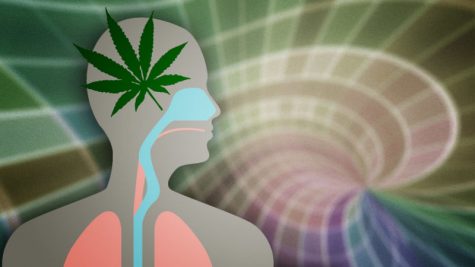The Highs and Lows of Smoking Marijuana
Pain pills vs. marijuana
We’ve all heard the fabrications about the infamous drug known as marijuana. Whether it’s called weed, Mary Jane, dope, cannabis, or pot this drug is the main gateway drug to all sorts of harder substances. Nevertheless, it’s rumored “beneficial” characteristics and renowned highs have appealed to people of all ages and ethnicities. It’s ability to reduce pain and distract the brain from stress has been popular among adolescents in particular, but how much do kids really know about what they are smoking? Is becoming a regular user of this drug going to lead to more harmful addictions in the future? No matter a person’s stance on this drug, staying informed about the effects of marijuana is important for anyone interested in using it.
The unfortunate thing about drugs is that some people have little to no knowledge about what they really do to the body, just that they helppain or provide a high. But here is what users need to understand: Marijuana enters the human body by affecting two main cannabinoid receptors. According to “The Unbiased Truth About Marijuana,” “CB1 is responsible for the immediate and psychoactive effects of marijuana, while CB2 determines the long-term and anti-inflammatory effects.” This fact seems to disprove the notion that marijuana has no long term consequences. As marijuana enters our cells, it resides in our systems for longer than just a few hours.
“Honestly I know very little about the effects marijuana has on your body. I know it can get people ‘high’ but I’ve never learned what it does in the long term,” said senior Olivia Davies.
Because most teens have only heard about the potential consequences that come from smoking weed in the short term, they fail to acknowledge what could happen in the future. The “American Academy of Child and Adolescent Psychiatry” states that using marijuana products can lead to difficulties focusing, increased aggression, problems with memory, unhealthy appetites, and more. Aside from mental changes, smoking marijuana can also alter standard health conditions like heart rate and blood pressure. This could potentially lead to dangerous things like heart disease, stroke, blood clots, and even dementia. “Statistics on Marijuana Use by Teens” states, “Research shows girls (ages 14-15) who used marijuana daily were 5 times more likely to face depression at age 21.” This means that if a teen falls into the trap of marijuana addiction in his or her early life, s/he is susceptible to mental health issues as well. Since this is the most common drug among teens, 1 in 6 kids will try marijuana before adulthood, which means they have a lifetime of adulthood to go downhill from there.
“I’m not really sure if marijuana has any long term effects on the body, but I would assume that smoking it or consuming it doesn’t do the body any good,” said junior Andrew Shankster.
Aside from the health issues smoking this drug can cause, there is also the debate over whether or not marijuana is linked to other problems, including substance abuse.
WebMD suggests that abusing marijuana can lead to the abuse of more harmful substances, stating, “Overall, the medical marijuana users had higher rates of alcohol and drug use than people in the general population.”
In other words, legalizing marijuana is likely to increase instances of substance abuse with other potentially fatal drugs.

Marijuana takes its long term habituation in the human body.
claims that marijuana use leads to a nine percent increase in the already sizable amount of deadly binge drinking instances. This means that more and more people are building up a tolerance to marijuana and moving onto stronger, more dangerous highs. With more people suffering from substance abuse, it is easy to see that smoking marijuana can have its downsides.
On the other hand, there is the debate about whether or not smoking weed for pain relief is cheaper and/or healthier than using over the counter drugs. Some say it is better to use a drug that does not directly attack the pain, but rather distracts from it, while others feel the opposite. The fact is, it is up for interpretation, but in terms of costs, the two could potentially be the same.
“I don’t think marijuana is cheap or necessarily safe if you are feeling pain. I think pills are the safe and better way to relieve stress,” said freshman Alexa Brown.
“I think taking the pills prescribed by doctors is healthier than ingesting smoke because they do not damage your lungs,” said senior Jack Bishop.
For teens like Brown and Bishop, smoking marijuana may just be viewed as something rebellious to do for fun, not for benefit. Ingesting smoke puts people at risk for lung cancer and breathing problems, and taking pills will always put people at risk for experiencing side effects. But when it comes to relieving pain, both ways are fairly successful as long as they are not abused.
One of the biggest problems with marijuana, aside from it being a gateway drug, is its easy accessibility. According to “Obtaining Marijuana Easy for Youth,” twenty-five percent of teens say that people in their neighborhoods are selling drugs, and one in six say that they have previously been approached by someone to buy marijuana. 12.7 million teens nationwide admit that if they wanted to attain marijuana, in any form, it would not be difficult. Therefore, with an eased ability to get a hold of this drug, and anything else needed to smoke it, it comes as no surprise to see so many teens with addictions. The inevitable will to try new things is what drives kids to try things like marijuana.
Nevertheless, this so-called fun activity may be putting adults and kids at risk for health issues beyond what they may be trying to relieve in the short term. Whether you are smoking it or ingesting it in some other way, marijuana is a drug, and it disrupts the basic bodily functions in more ways than one. When prescribed by a doctor in healthy amounts, harm could be minimal, but for kids searching for a new adrenaline rush, this may not be the best choice.







